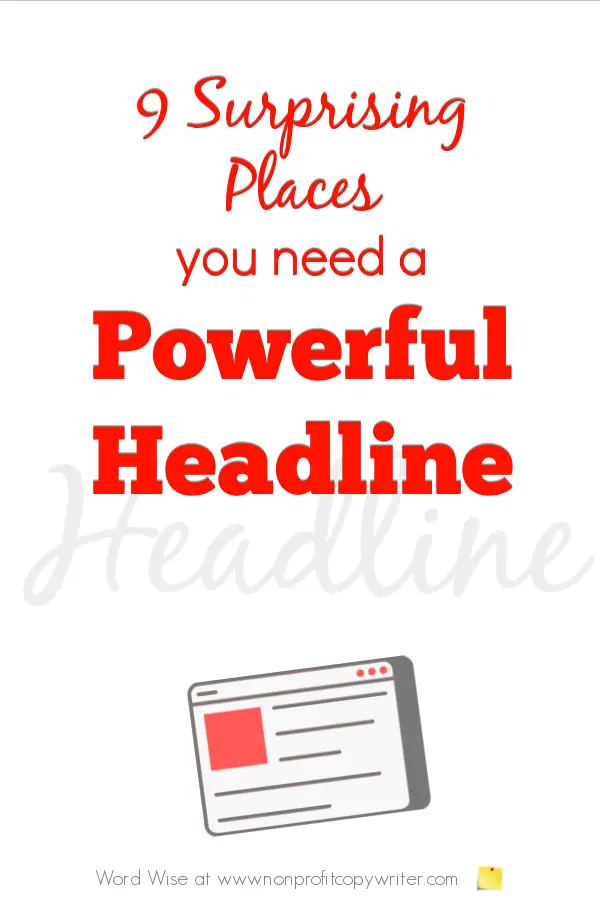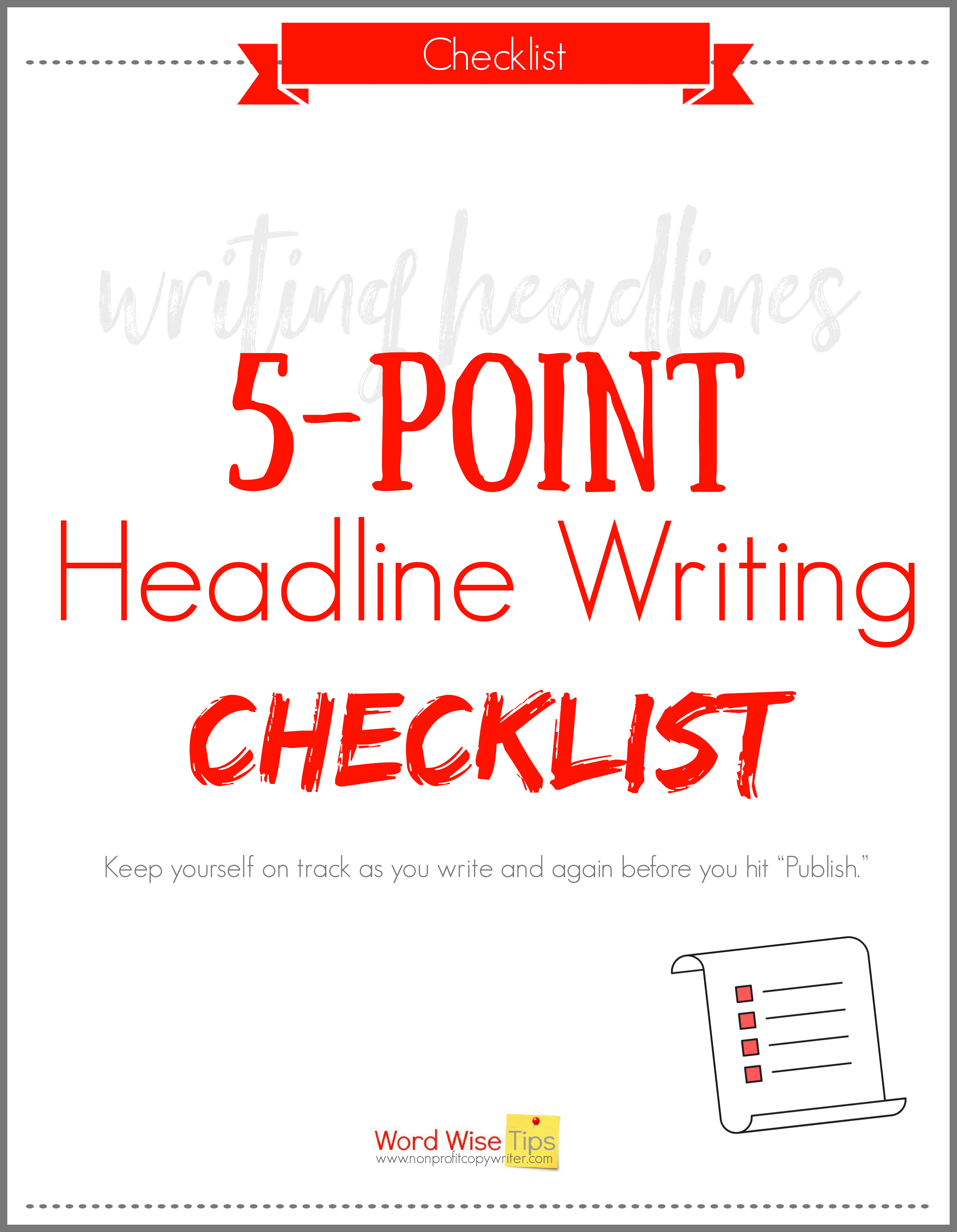Save Time: Get 5 Simple Writing Tips
you can put to use in 10 minutes
The Most Surprising Places You Need a Powerful Headline
Award-winning writer Kathy Widenhouse has helped hundreds of nonprofits and writers produce successful content , with 750K+ views for her writing tutorials. She is the author of 9 books. See more of Kathy’s content here.
Updated 2.13.25
It’s been drilled into you from the beginning: you must have a powerful headline for your article, blog post, or web page.
But what about all the other places you need a powerful headline … and may not know it?
A headline is text that introduces the subject matter of the piece and pulls in the reader by attracting attention, announcing news, offering a benefit, asking a question, providing useful information, explaining how or why, presenting a problem and a solution … (more ways a headline convinces a reader to keep reading.)
Today, content is not limited to articles, blog posts, and web pages. Content is everywhere and it comes in all forms, which means that you can apply long-established headline-writing rules for articles, blogs, and websites to headlines in other media. “We now have to craft an eye-catching, clickable headline for almost every channel where our content can be discovered,” says Ash Read, editorial director at social media software giant Buffer.
These channels are not necessarily structured to kick off with a traditional headline at the top. Nevertheless, their introductory text acts as a headline. Treat the opening text like a headline and you’ll pull the reader in. Slant your headline to the channel’s mode of operation, and you’ll have even more success.
Where are these places that beg for powerful headline-like text and how should you slant each kind? Take a look.
9 Places You Need a Powerful Headline (And You May Not Know It)
1. Tweets: Your Headline Should Generate Curiosity
Twitter limits posts to 280 characters including spaces and other symbols. Good tweets act like a headline – they’re quick, simple, and easy to process. The best tweets offer a benefit or generate curiosity with an interesting fact or question, with the keywords front loaded in the first 50-60 characters. (Here are 10 tips for writing good tweets.)
2. Facebook Posts: Your Headline Should Be Personal
Long or short, your Facebook posts need to grab attention. Readers scroll through their feeds and may not stop unless you capture them with the first few words of your post. Use Facebook’s slant towards personal stories and opinion as you write headlines – your post’s opening line – in a conversational, “you-me” style. Facebook post titles with 90 characters or less receive the highest number of shares.
3. Photo Captions: Your Headline Should Give New Information
Photos in an article, blog post, or web page act as mini-headlines, but don’t use them to repeat what you’ve already written in the main heading or body content. Use captions to give the reader new information.
4. Instagram Captions: Your Headline Should Entertain
Entertaining: that’s the byword for Instagram captions. Here’s where you write a funny, fascinating, or provocative headline – one that reflects your personality or brand. Be sure to lead off your captions with the image’s keywords. Keep Instagram captions to 125 characters or less.
5. Search Engine Meta Titles: Your Headline Should Front Load Keywords
A meta title is the text that appears as the page title in a web browser. You add the title tag in the back end or header of your site (depending on your website platform) as you write the page. The best meta titles are 50-60 words. Longer than that will be cut off by the browser. The key to powerful headlines in meta titles? Use the page’s keywords. Front load the keyword or phrase at the beginning of the meta title.
And while you’re loading the page, make sure you headline-ize its meta description. That’s the snippet of content that appears below a page link on search results. Keep the meta description to 160 characters or less, if possible, because search engines like brevity. And be sure to include your web page’s keywords in the first part of the meta description. Why? Because readers use keywords to search. When they see keywords in the description, they’re more likely to click on the page.
6. Email Subject Lines: Your Headline Should Convey Urgency
Your own email inbox is flooded, right? It’s easy to click “Delete” without opening an email. An email subject line is a headline in disguise. It’s most effective when you include urgency (such as a time limit) and special offers. Email subject lines can top out at 27 to 77 characters depending on which kind of device is used to view them, but those subject lines with 35 characters or less get the best open rates.
7. Lead Magnet Opt-Ins: Your Headline Should Solve a Problem
Freebies are everywhere and people love them. I do! But a lead magnet opt-in is not all that unusual anymore. If I’m a reader, what makes me opt-in (“convert” in digital lingo) is a freebie that you really, really want.
You can pull readers when your opt-in headline identifies the pain points of the people in your niche. Choose just one problem your target prospect faces. Let your lead magnet headline address the problem and how your download will solve it.
8. Tag Lines/Subtitles: Your Headline Should Identify Your Audience
Your book or eBook’s title piques interest. But use the book’s subtitle or tag line to identify the specific reader that will benefit from it.
9. Subheads: Your Headline Should Be Skimmable
Subheads act like miniature headlines, each introducing a new section of content. They work as a “quick reading” tool allowing readers to scan, which make subheads obligatory in today’s skimmable content.
Write a piece of any substantial length and you must include subheads or you run the risk of reader’s saying, “TLDR” (Too Long, Didn’t Read.) A headline pulls the reader into a piece. Then she skims the subheads to see if she wants to take the time to read the whole piece. Arrange these mini-headlines as an outline for your article or post, with each one summarizing a benefit of its section’s content. (Here are tips for writing subheads.)
More Headline Writing Tips
10 words to use when writing headlines ...
Write Great Headlines With One Simple Formula ...
How to Write How-To Headlines That Pull in More Readers ...
When Do Question Headlines Work?
Top 12 Headline Templates and Why They Work ...
The Problem with Clickbait Headlines (and how to solve it) ...
Writing Better Headlines: Simple As 3 + 3 ...
7 Tips for Using Numbers in Headlines ...
Write a Better Headline When You Answer One Simple Question ...
Top 27 copywriting headlines tips: getting started, headline mechanics ...
5-point checklist to use when you write a headline ...
6 secrets of effective subheads ...
Basics for copywriting headlines ...
The 4 U's: use this checklist for writing powerful headlines ...
See more tips on our Writing Headlines Pinterest board...
Return from The Most Surprising Places You Need a Powerful Headline to
Nonprofit Copywriter home
As an Amazon Associate I earn from qualifying purchases.
Share This Page

Named to 2022 Writer's Digest list
BEST GENRE/NICHE WRITING WEBSITE


Stop Wasting Time!
Grab your exclusive FREE guide, "5 Simple Writing Tips You Can Put to Use in 10 Minutes or Less"













